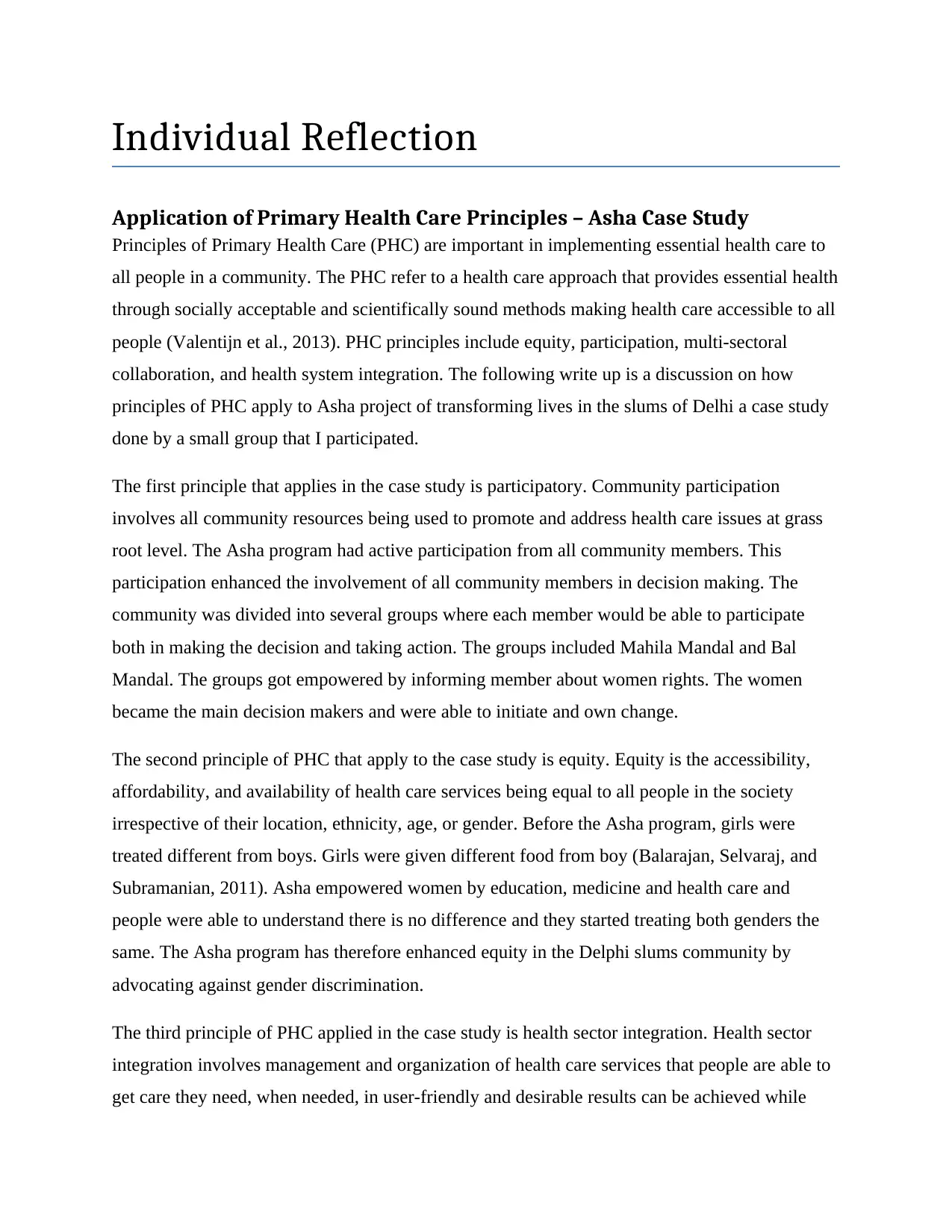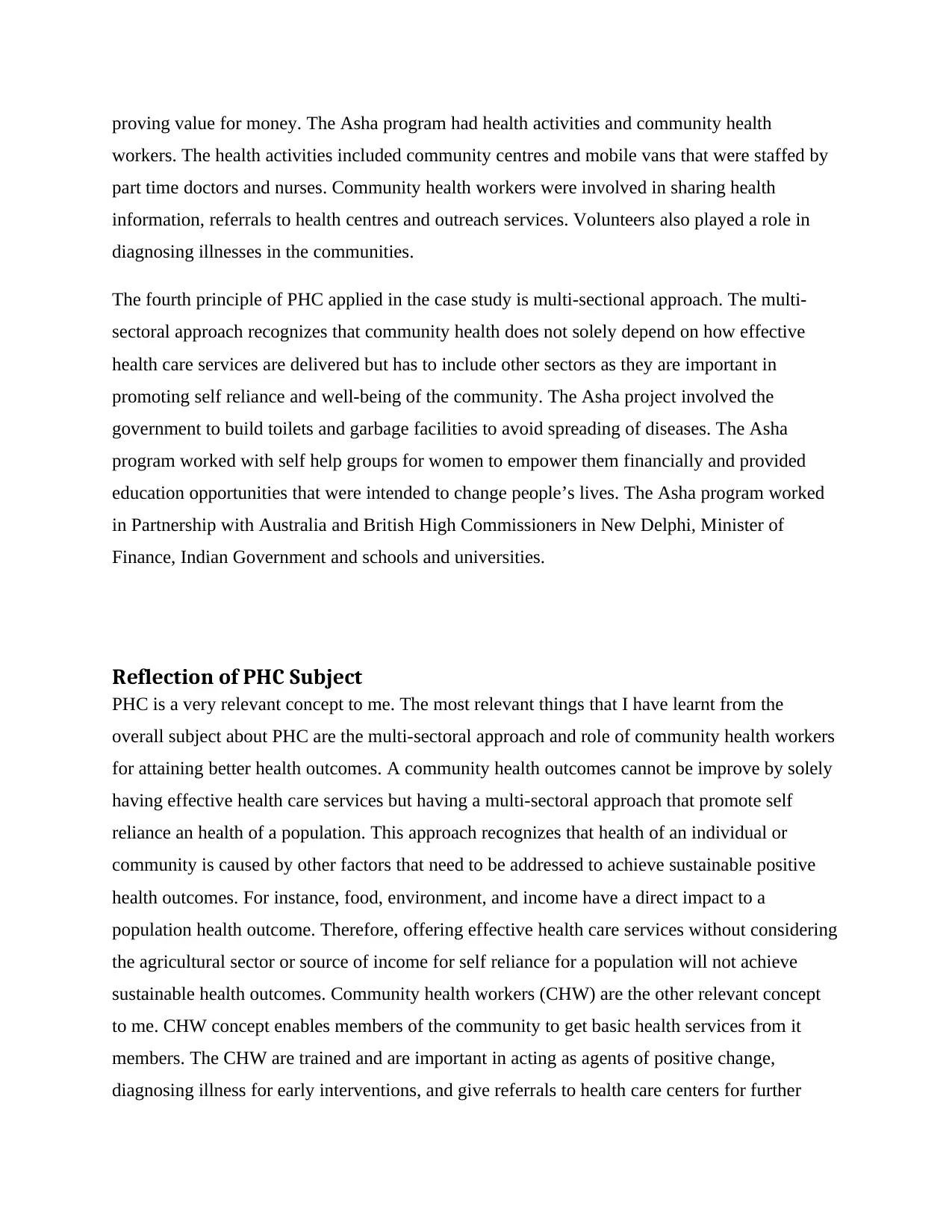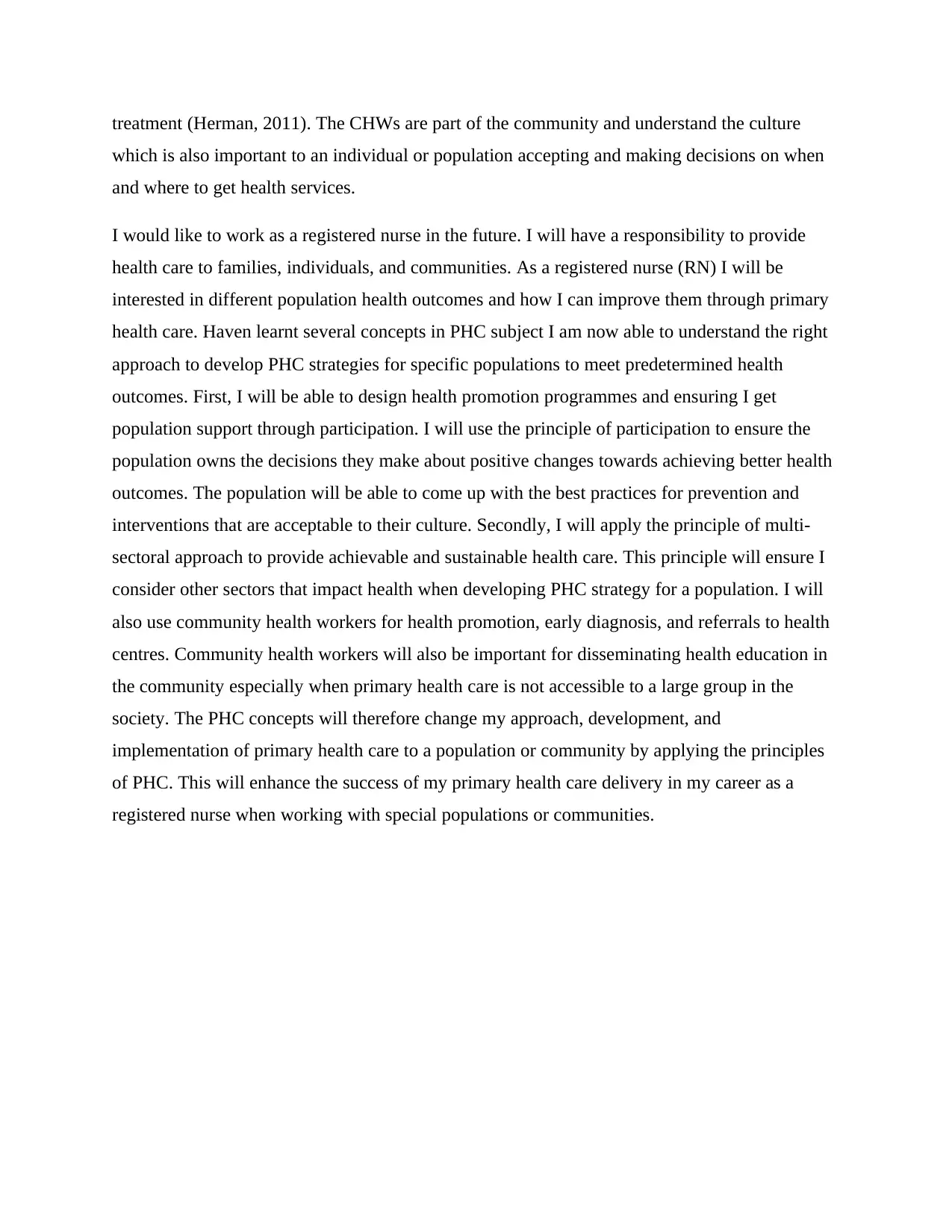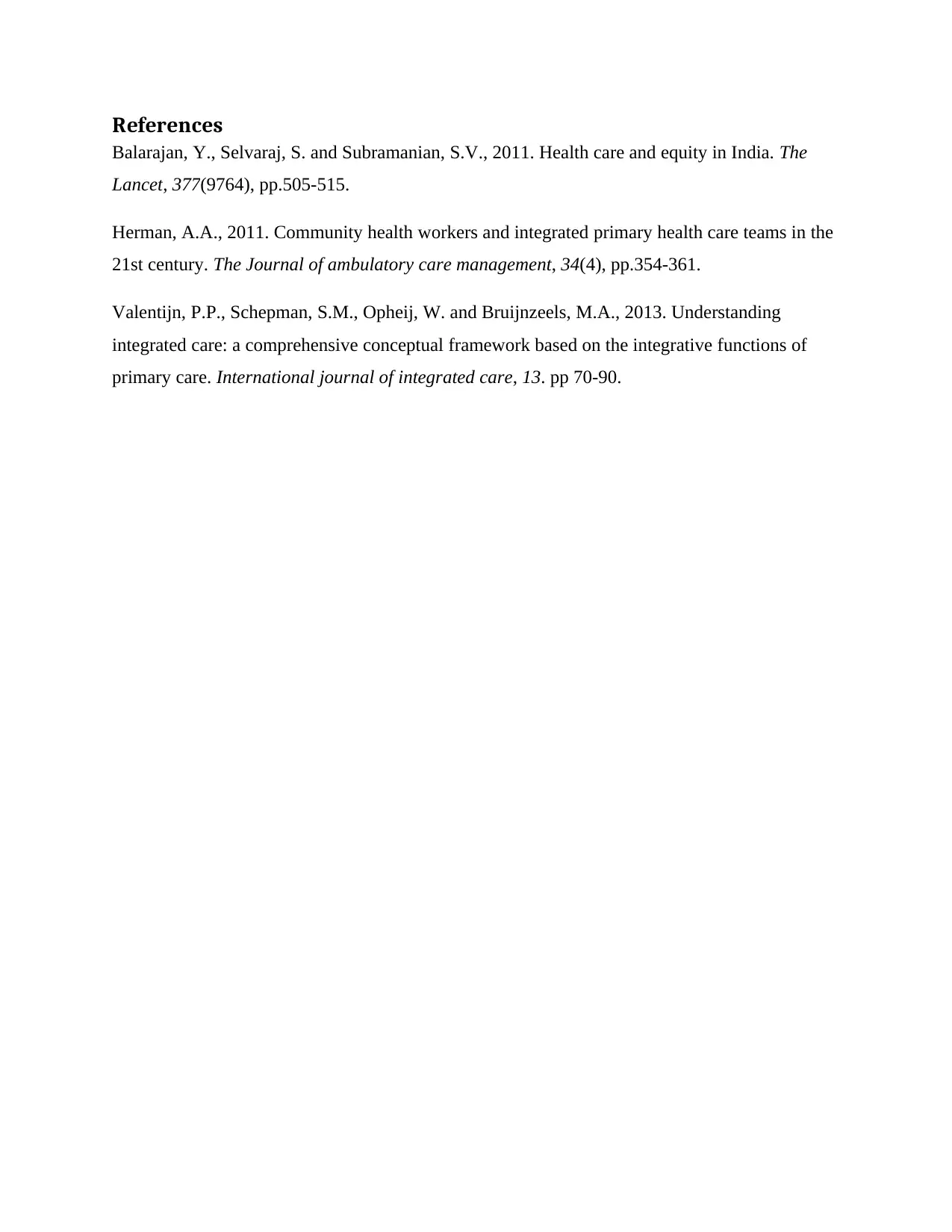Asha Case Study: Reflection on Applying Primary Health Care Principles
VerifiedAdded on 2023/06/10
|5
|1259
|458
Case Study
AI Summary
This assignment provides an individual reflection on the application of Primary Health Care (PHC) principles to the Asha project, which focuses on transforming lives in the slums of Delhi. It highlights the principles of participation, equity, health sector integration, and multi-sectoral collaboration as they relate to the Asha program. The reflection emphasizes the importance of community involvement, addressing gender discrimination, integrating health services, and involving various sectors like government and education to promote self-reliance and well-being. The author reflects on the relevance of the multi-sectoral approach and the role of community health workers (CHW) in achieving better health outcomes. The author intends to apply these lessons in their future career as a registered nurse, focusing on designing health promotion programs, ensuring community support, and utilizing CHWs for health education and early intervention.

UNIT:
NAME:
DATE:
NAME:
DATE:
Paraphrase This Document
Need a fresh take? Get an instant paraphrase of this document with our AI Paraphraser

Individual Reflection
Application of Primary Health Care Principles – Asha Case Study
Principles of Primary Health Care (PHC) are important in implementing essential health care to
all people in a community. The PHC refer to a health care approach that provides essential health
through socially acceptable and scientifically sound methods making health care accessible to all
people (Valentijn et al., 2013). PHC principles include equity, participation, multi-sectoral
collaboration, and health system integration. The following write up is a discussion on how
principles of PHC apply to Asha project of transforming lives in the slums of Delhi a case study
done by a small group that I participated.
The first principle that applies in the case study is participatory. Community participation
involves all community resources being used to promote and address health care issues at grass
root level. The Asha program had active participation from all community members. This
participation enhanced the involvement of all community members in decision making. The
community was divided into several groups where each member would be able to participate
both in making the decision and taking action. The groups included Mahila Mandal and Bal
Mandal. The groups got empowered by informing member about women rights. The women
became the main decision makers and were able to initiate and own change.
The second principle of PHC that apply to the case study is equity. Equity is the accessibility,
affordability, and availability of health care services being equal to all people in the society
irrespective of their location, ethnicity, age, or gender. Before the Asha program, girls were
treated different from boys. Girls were given different food from boy (Balarajan, Selvaraj, and
Subramanian, 2011). Asha empowered women by education, medicine and health care and
people were able to understand there is no difference and they started treating both genders the
same. The Asha program has therefore enhanced equity in the Delphi slums community by
advocating against gender discrimination.
The third principle of PHC applied in the case study is health sector integration. Health sector
integration involves management and organization of health care services that people are able to
get care they need, when needed, in user-friendly and desirable results can be achieved while
Application of Primary Health Care Principles – Asha Case Study
Principles of Primary Health Care (PHC) are important in implementing essential health care to
all people in a community. The PHC refer to a health care approach that provides essential health
through socially acceptable and scientifically sound methods making health care accessible to all
people (Valentijn et al., 2013). PHC principles include equity, participation, multi-sectoral
collaboration, and health system integration. The following write up is a discussion on how
principles of PHC apply to Asha project of transforming lives in the slums of Delhi a case study
done by a small group that I participated.
The first principle that applies in the case study is participatory. Community participation
involves all community resources being used to promote and address health care issues at grass
root level. The Asha program had active participation from all community members. This
participation enhanced the involvement of all community members in decision making. The
community was divided into several groups where each member would be able to participate
both in making the decision and taking action. The groups included Mahila Mandal and Bal
Mandal. The groups got empowered by informing member about women rights. The women
became the main decision makers and were able to initiate and own change.
The second principle of PHC that apply to the case study is equity. Equity is the accessibility,
affordability, and availability of health care services being equal to all people in the society
irrespective of their location, ethnicity, age, or gender. Before the Asha program, girls were
treated different from boys. Girls were given different food from boy (Balarajan, Selvaraj, and
Subramanian, 2011). Asha empowered women by education, medicine and health care and
people were able to understand there is no difference and they started treating both genders the
same. The Asha program has therefore enhanced equity in the Delphi slums community by
advocating against gender discrimination.
The third principle of PHC applied in the case study is health sector integration. Health sector
integration involves management and organization of health care services that people are able to
get care they need, when needed, in user-friendly and desirable results can be achieved while

proving value for money. The Asha program had health activities and community health
workers. The health activities included community centres and mobile vans that were staffed by
part time doctors and nurses. Community health workers were involved in sharing health
information, referrals to health centres and outreach services. Volunteers also played a role in
diagnosing illnesses in the communities.
The fourth principle of PHC applied in the case study is multi-sectional approach. The multi-
sectoral approach recognizes that community health does not solely depend on how effective
health care services are delivered but has to include other sectors as they are important in
promoting self reliance and well-being of the community. The Asha project involved the
government to build toilets and garbage facilities to avoid spreading of diseases. The Asha
program worked with self help groups for women to empower them financially and provided
education opportunities that were intended to change people’s lives. The Asha program worked
in Partnership with Australia and British High Commissioners in New Delphi, Minister of
Finance, Indian Government and schools and universities.
Reflection of PHC Subject
PHC is a very relevant concept to me. The most relevant things that I have learnt from the
overall subject about PHC are the multi-sectoral approach and role of community health workers
for attaining better health outcomes. A community health outcomes cannot be improve by solely
having effective health care services but having a multi-sectoral approach that promote self
reliance an health of a population. This approach recognizes that health of an individual or
community is caused by other factors that need to be addressed to achieve sustainable positive
health outcomes. For instance, food, environment, and income have a direct impact to a
population health outcome. Therefore, offering effective health care services without considering
the agricultural sector or source of income for self reliance for a population will not achieve
sustainable health outcomes. Community health workers (CHW) are the other relevant concept
to me. CHW concept enables members of the community to get basic health services from it
members. The CHW are trained and are important in acting as agents of positive change,
diagnosing illness for early interventions, and give referrals to health care centers for further
workers. The health activities included community centres and mobile vans that were staffed by
part time doctors and nurses. Community health workers were involved in sharing health
information, referrals to health centres and outreach services. Volunteers also played a role in
diagnosing illnesses in the communities.
The fourth principle of PHC applied in the case study is multi-sectional approach. The multi-
sectoral approach recognizes that community health does not solely depend on how effective
health care services are delivered but has to include other sectors as they are important in
promoting self reliance and well-being of the community. The Asha project involved the
government to build toilets and garbage facilities to avoid spreading of diseases. The Asha
program worked with self help groups for women to empower them financially and provided
education opportunities that were intended to change people’s lives. The Asha program worked
in Partnership with Australia and British High Commissioners in New Delphi, Minister of
Finance, Indian Government and schools and universities.
Reflection of PHC Subject
PHC is a very relevant concept to me. The most relevant things that I have learnt from the
overall subject about PHC are the multi-sectoral approach and role of community health workers
for attaining better health outcomes. A community health outcomes cannot be improve by solely
having effective health care services but having a multi-sectoral approach that promote self
reliance an health of a population. This approach recognizes that health of an individual or
community is caused by other factors that need to be addressed to achieve sustainable positive
health outcomes. For instance, food, environment, and income have a direct impact to a
population health outcome. Therefore, offering effective health care services without considering
the agricultural sector or source of income for self reliance for a population will not achieve
sustainable health outcomes. Community health workers (CHW) are the other relevant concept
to me. CHW concept enables members of the community to get basic health services from it
members. The CHW are trained and are important in acting as agents of positive change,
diagnosing illness for early interventions, and give referrals to health care centers for further
⊘ This is a preview!⊘
Do you want full access?
Subscribe today to unlock all pages.

Trusted by 1+ million students worldwide

treatment (Herman, 2011). The CHWs are part of the community and understand the culture
which is also important to an individual or population accepting and making decisions on when
and where to get health services.
I would like to work as a registered nurse in the future. I will have a responsibility to provide
health care to families, individuals, and communities. As a registered nurse (RN) I will be
interested in different population health outcomes and how I can improve them through primary
health care. Haven learnt several concepts in PHC subject I am now able to understand the right
approach to develop PHC strategies for specific populations to meet predetermined health
outcomes. First, I will be able to design health promotion programmes and ensuring I get
population support through participation. I will use the principle of participation to ensure the
population owns the decisions they make about positive changes towards achieving better health
outcomes. The population will be able to come up with the best practices for prevention and
interventions that are acceptable to their culture. Secondly, I will apply the principle of multi-
sectoral approach to provide achievable and sustainable health care. This principle will ensure I
consider other sectors that impact health when developing PHC strategy for a population. I will
also use community health workers for health promotion, early diagnosis, and referrals to health
centres. Community health workers will also be important for disseminating health education in
the community especially when primary health care is not accessible to a large group in the
society. The PHC concepts will therefore change my approach, development, and
implementation of primary health care to a population or community by applying the principles
of PHC. This will enhance the success of my primary health care delivery in my career as a
registered nurse when working with special populations or communities.
which is also important to an individual or population accepting and making decisions on when
and where to get health services.
I would like to work as a registered nurse in the future. I will have a responsibility to provide
health care to families, individuals, and communities. As a registered nurse (RN) I will be
interested in different population health outcomes and how I can improve them through primary
health care. Haven learnt several concepts in PHC subject I am now able to understand the right
approach to develop PHC strategies for specific populations to meet predetermined health
outcomes. First, I will be able to design health promotion programmes and ensuring I get
population support through participation. I will use the principle of participation to ensure the
population owns the decisions they make about positive changes towards achieving better health
outcomes. The population will be able to come up with the best practices for prevention and
interventions that are acceptable to their culture. Secondly, I will apply the principle of multi-
sectoral approach to provide achievable and sustainable health care. This principle will ensure I
consider other sectors that impact health when developing PHC strategy for a population. I will
also use community health workers for health promotion, early diagnosis, and referrals to health
centres. Community health workers will also be important for disseminating health education in
the community especially when primary health care is not accessible to a large group in the
society. The PHC concepts will therefore change my approach, development, and
implementation of primary health care to a population or community by applying the principles
of PHC. This will enhance the success of my primary health care delivery in my career as a
registered nurse when working with special populations or communities.
Paraphrase This Document
Need a fresh take? Get an instant paraphrase of this document with our AI Paraphraser

References
Balarajan, Y., Selvaraj, S. and Subramanian, S.V., 2011. Health care and equity in India. The
Lancet, 377(9764), pp.505-515.
Herman, A.A., 2011. Community health workers and integrated primary health care teams in the
21st century. The Journal of ambulatory care management, 34(4), pp.354-361.
Valentijn, P.P., Schepman, S.M., Opheij, W. and Bruijnzeels, M.A., 2013. Understanding
integrated care: a comprehensive conceptual framework based on the integrative functions of
primary care. International journal of integrated care, 13. pp 70-90.
Balarajan, Y., Selvaraj, S. and Subramanian, S.V., 2011. Health care and equity in India. The
Lancet, 377(9764), pp.505-515.
Herman, A.A., 2011. Community health workers and integrated primary health care teams in the
21st century. The Journal of ambulatory care management, 34(4), pp.354-361.
Valentijn, P.P., Schepman, S.M., Opheij, W. and Bruijnzeels, M.A., 2013. Understanding
integrated care: a comprehensive conceptual framework based on the integrative functions of
primary care. International journal of integrated care, 13. pp 70-90.
1 out of 5
Related Documents
Your All-in-One AI-Powered Toolkit for Academic Success.
+13062052269
info@desklib.com
Available 24*7 on WhatsApp / Email
![[object Object]](/_next/static/media/star-bottom.7253800d.svg)
Unlock your academic potential
Copyright © 2020–2025 A2Z Services. All Rights Reserved. Developed and managed by ZUCOL.





